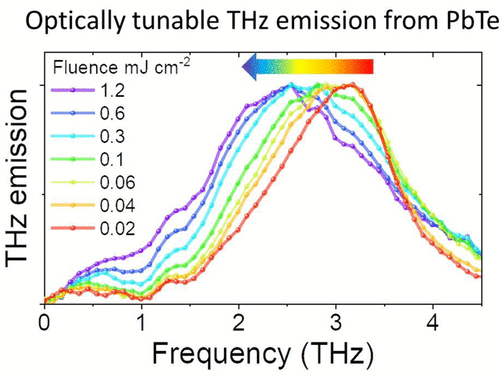当前位置:
X-MOL 学术
›
ACS Photonics
›
论文详情
Our official English website, www.x-mol.net, welcomes your feedback! (Note: you will need to create a separate account there.)
Dynamically Tunable Terahertz Emission Enabled by Anomalous Optical Phonon Responses in Lead Telluride
ACS Photonics ( IF 7 ) Pub Date : 2021-11-22 , DOI: 10.1021/acsphotonics.1c01291 Burak Guzelturk 1, 2, 3 , Mariano Trigo 1, 4 , Olivier Delaire 5, 6 , David A. Reis 1, 4, 7, 8 , Aaron M. Lindenberg 1, 2, 4, 8
ACS Photonics ( IF 7 ) Pub Date : 2021-11-22 , DOI: 10.1021/acsphotonics.1c01291 Burak Guzelturk 1, 2, 3 , Mariano Trigo 1, 4 , Olivier Delaire 5, 6 , David A. Reis 1, 4, 7, 8 , Aaron M. Lindenberg 1, 2, 4, 8
Affiliation

|
Lead telluride (PbTe), a narrow bandgap semiconductor commonly used in infrared detectors, exhibits anomalous vibrational and structural properties, making it appealing for thermoelectrics. Despite significant fundamental interest in the microscopic origins of its unusual vibrational properties, the optical functionalities stemming from phonons and electron–phonon coupling in PbTe have not been closely investigated. This paper reports measurements of terahertz (THz) radiation from a PbTe single crystal following ultrafast optical excitation and investigates IR-active phonon responses as a function of excitation fluence and temperature. We uncover a spectrally tunable THz emission peak enabled by an epsilon-near-zero response of the coupled plasmon–longitudinal optical phonon mode that can be dynamically shifted via tuning photocarrier density. Spectral tunability (Δω/ω = 25%) is significant and beyond what has been achieved by any other THz emitter. In addition, the emitted THz fields reveal signatures of a zone center transverse optical phonon anomaly and unveil a new mode at 0.3 THz that diminishes in amplitude under increasing photocarrier density. Temperature-dependent measurements suggest that the transverse-like modes at 1 and 1.5 THz are possibly of different origins. These results indicate that the unusual phononic properties in PbTe are tunable via photoexcitation and enable new optical functionalities in THz applications, such as spectrally tunable emitters and all-optical modulators.
中文翻译:

碲化铅中异常光声子响应实现的动态可调太赫兹发射
碲化铅 (PbTe) 是一种常用于红外探测器的窄带隙半导体,表现出异常的振动和结构特性,使其对热电材料具有吸引力。尽管对其不寻常的振动特性的微观起源具有重大的基本兴趣,但尚未仔细研究源自 PbTe 中声子和电子-声子耦合的光学功能。本文报告了在超快光激发后对 PbTe 单晶的太赫兹 (THz) 辐射的测量,并研究了作为激发通量和温度函数的 IR 活性声子响应。我们发现了一个光谱可调的太赫兹发射峰,该峰由耦合等离子体纵向光学声子模式的 epsilon 近零响应启用,该模式可以通过调整光载流子密度动态移动。光谱可调性 (Δω/ω = 25%) 非常重要,并且超出了任何其他太赫兹发射器所能达到的水平。此外,发射的太赫兹场揭示了区域中心横向光学声子异常的特征,并在 0.3 太赫兹处揭示了一种新模式,该模式在增加光载流子密度时振幅会减小。与温度相关的测量表明,1 和 1.5 THz 处的类似横向模式可能来自不同的起源。这些结果表明,PbTe 中不寻常的声子特性可以通过光激发进行调节,并在太赫兹应用中实现新的光学功能,例如光谱可调发射器和全光调制器。发射的太赫兹场揭示了区域中心横向光学声子异常的特征,并在 0.3 太赫兹处揭示了一种新模式,该模式在增加光载流子密度时振幅减小。与温度相关的测量表明,1 和 1.5 THz 处的类似横向模式可能来自不同的起源。这些结果表明,PbTe 中不寻常的声子特性可以通过光激发进行调节,并在太赫兹应用中实现新的光学功能,例如光谱可调发射器和全光调制器。发射的太赫兹场揭示了区域中心横向光学声子异常的特征,并在 0.3 太赫兹处揭示了一种新模式,该模式在增加光载流子密度时振幅减小。与温度相关的测量表明,1 和 1.5 THz 处的类似横向模式可能来自不同的起源。这些结果表明,PbTe 中不寻常的声子特性可以通过光激发进行调节,并在太赫兹应用中实现新的光学功能,例如光谱可调发射器和全光调制器。
更新日期:2021-12-15
中文翻译:

碲化铅中异常光声子响应实现的动态可调太赫兹发射
碲化铅 (PbTe) 是一种常用于红外探测器的窄带隙半导体,表现出异常的振动和结构特性,使其对热电材料具有吸引力。尽管对其不寻常的振动特性的微观起源具有重大的基本兴趣,但尚未仔细研究源自 PbTe 中声子和电子-声子耦合的光学功能。本文报告了在超快光激发后对 PbTe 单晶的太赫兹 (THz) 辐射的测量,并研究了作为激发通量和温度函数的 IR 活性声子响应。我们发现了一个光谱可调的太赫兹发射峰,该峰由耦合等离子体纵向光学声子模式的 epsilon 近零响应启用,该模式可以通过调整光载流子密度动态移动。光谱可调性 (Δω/ω = 25%) 非常重要,并且超出了任何其他太赫兹发射器所能达到的水平。此外,发射的太赫兹场揭示了区域中心横向光学声子异常的特征,并在 0.3 太赫兹处揭示了一种新模式,该模式在增加光载流子密度时振幅会减小。与温度相关的测量表明,1 和 1.5 THz 处的类似横向模式可能来自不同的起源。这些结果表明,PbTe 中不寻常的声子特性可以通过光激发进行调节,并在太赫兹应用中实现新的光学功能,例如光谱可调发射器和全光调制器。发射的太赫兹场揭示了区域中心横向光学声子异常的特征,并在 0.3 太赫兹处揭示了一种新模式,该模式在增加光载流子密度时振幅减小。与温度相关的测量表明,1 和 1.5 THz 处的类似横向模式可能来自不同的起源。这些结果表明,PbTe 中不寻常的声子特性可以通过光激发进行调节,并在太赫兹应用中实现新的光学功能,例如光谱可调发射器和全光调制器。发射的太赫兹场揭示了区域中心横向光学声子异常的特征,并在 0.3 太赫兹处揭示了一种新模式,该模式在增加光载流子密度时振幅减小。与温度相关的测量表明,1 和 1.5 THz 处的类似横向模式可能来自不同的起源。这些结果表明,PbTe 中不寻常的声子特性可以通过光激发进行调节,并在太赫兹应用中实现新的光学功能,例如光谱可调发射器和全光调制器。


























 京公网安备 11010802027423号
京公网安备 11010802027423号